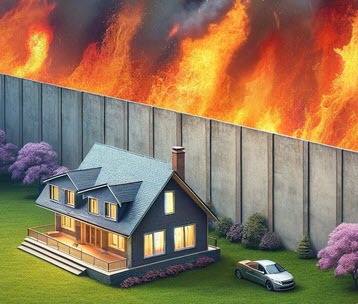Understanding the Risks of Living in a Fire Zone in Colorado
Colorado is known for its stunning landscapes and outdoor recreational opportunities. However, it also faces the constant threat of wildfires.The state has experienced devastating fires in recent years, such as the Marshall Fire, which destroyed hundreds of homes and forced thousands of people to evacuate. This incident serves as a stark reminder of the severity of the risk that homeowners in fire-prone areas face.
There are several factors that contribute to the heightened risk of wildfires in Colorado. The state’s climate conditions, characterized by dry and hot summers, create the perfect conditions for fires to ignite and spread rapidly. Additionally, human activities, such as careless campfire use, discarded cigarettes, and even arson, can spark wildfires.
To understand the risks associated with living in a fire zone in Colorado, it is important for homeowners to be aware of the potential dangers they face. This knowledge empowers them to take necessary precautions to protect their properties and loved ones. By understanding the risks, homeowners can make informed decisions about their insurance coverage and implement strategies to mitigate the potential damage caused by wildfires.
For example, homeowners can take steps to create defensible space around their properties by clearing vegetation and flammable materials. They can also install fire-resistant roofing materials, which can provide an added layer of protection against embers and flames. These proactive measures can significantly reduce the vulnerability of homes to wildfires.By investing in fire prevention measures, homeowners demonstrate their commitment to protecting their properties and reducing the risk of fire damage.
Furthermore, it is crucial for homeowners to stay informed about the specific wildfire risks in their area. They can access resources such as the Colorado Forest Atlas Wildfire Risk Viewer, which provides valuable information about fire zones, fire seasons, weather patterns, and the wildland-urban interface. By understanding the specific risks they face, homeowners can make more informed decisions about their insurance needs and take appropriate actions to mitigate those risks.
Insurance Coverage Options for Homes in High Wildfire Risk Areas
When it comes to insurance coverage for homes in high wildfire risk areas, homeowners insurance is the main form of protection.While specific wildfire insurance coverage does not exist in Colorado, homeowners insurance policies generally cover fire damage, including damage caused by wildfires. It is important for homeowners to carefully review their policy to ensure that it adequately covers fire-related perils and includes any additional coverage options that may be necessary for their specific situation.
Homeowners insurance provides comprehensive coverage, not only for fire-related perils but also for other risks and liabilities. It typically covers the structure of the home, personal belongings, and liability for injuries or property damage caused by the homeowner or their family members. This coverage is crucial in the event of a wildfire, as it can help homeowners recover financially from the devastating effects of a fire.
For example, if a homeowner’s property is damaged or destroyed by a wildfire, their homeowners insurance policy can provide funds to repair or rebuild the home. Additionally, the policy may cover the cost of replacing personal belongings that were lost or damaged in the fire. This financial protection can be a lifeline for homeowners who have experienced such a devastating event.
It is important for homeowners to review their homeowners insurance policy regularly to ensure that it provides adequate coverage for their needs. They should also consider any additional coverage options that may be available, such as extended replacement cost coverage or coverage for additional living expenses in the event that they are displaced from their home due to a fire. By understanding their insurance coverage options, homeowners can make informed decisions and ensure that they are adequately protected in the event of a wildfire.
In addition to homeowners insurance, there are other insurance options that homeowners in high wildfire risk areas may consider. For example, some homeowners may choose to purchase an umbrella insurance policy, which provides additional liability coverage that extends beyond the limits of their primary homeowners insurance policy. This can be beneficial in situations where the costs of damages or injuries exceed the coverage limits of the homeowners policy.
Another potential insurance option for homeowners in high wildfire risk areas is excess or surplus lines insurance. These types of insurance policies are provided by non-admitted insurance carriers and offer coverage for risks that are not typically covered by standard homeowners insurance policies. While these policies may come with higher premiums, they can provide an extra layer of protection for homeowners in fire-prone areas.
It is important for homeowners to carefully consider their insurance options and choose the coverage that best suits their needs. Consulting with a licensed insurance agent who specializes in homeowners insurance can be beneficial in navigating the available options and finding the right coverage for their specific situation.
Mitigating the Risk and Lowering Insurance Premiums
While homeowners insurance provides important financial protection, taking steps to mitigate the risk of fire damage can help lower insurance premiums.Insurance companies assess fire risk using different sources and methodologies, and homeowners who take proactive measures to reduce the risk of fire may qualify for premium discounts from select insurance companies.
There are several strategies that homeowners can implement to mitigate the risk of fire damage. One of the most effective measures is creating defensible space around the property. This involves clearing vegetation and flammable materials from the immediate vicinity of the home, creating a buffer zone that can help prevent the spread of wildfires.By implementing defensible space measures, homeowners can significantly reduce the vulnerability of their homes to fire.
Additionally, homeowners can take steps to make their homes more fire-resistant. This can include installing fire-resistant roofing materials, using fire-resistant siding, and sealing any gaps or openings that could allow embers to enter the home. These measures can help reduce the risk of fire damage and may result in lower insurance premiums.
Another important aspect of fire mitigation is being prepared for wildfires. This includes having an evacuation plan in place, keeping important documents and valuables in a safe location, and ensuring that the property has adequate access for firefighters in case of an emergency. By being prepared and taking proactive measures, homeowners can not only lower their insurance premiums but also increase their chances of protecting their homes and loved ones in the event of a wildfire.
It is worth noting that some insurance companies offer discounts or incentives for homeowners who have implemented fire prevention measures. For example, homeowners who have installed fire-resistant roofing materials or have a defensible space around their property may be eligible for lower premiums. It is advisable for homeowners to inquire with their insurance provider about any potential discounts or incentives for fire mitigation measures.
By taking proactive steps to mitigate the risk of fire damage, homeowners can not only protect their properties and loved ones but also potentially lower their insurance premiums. It is important to consult with insurance professionals and local fire departments to ensure that the measures taken are effective and in compliance with local regulations and guidelines.
Factors to Consider When Choosing a Homeowners Insurance Policy
When choosing a homeowners insurance policy in a fire zone, there are several important factors that homeowners should consider. These factors can significantly impact the coverage, cost, and overall suitability of the insurance policy.
One of the primary factors that influence homeowners insurance costs is the location of the property. Insurance companies assess the risk of fire damage based on the proximity of the property to areas prone to wildfires. Homes located in high-risk fire zones may have higher insurance premiums compared to those in low-risk areas.
Home characteristics also play a role in determining insurance costs. The size, age, construction materials, and overall condition of the home can affect the risk of fire damage and, consequently, the insurance premiums. Homes with fire-resistant features, such as fire-resistant roofing materials or a sprinkler system, may be eligible for lower insurance rates.
Another factor that insurance companies consider is the homeowner’s credit-based insurance score. This score is based on the homeowner’s credit history and helps insurers assess the risk of future claims. A higher credit-based insurance score may result in lower insurance premiums, as it indicates a lower likelihood of filing a claim.
The deductible and coverage amount selected by the homeowner also impact insurance costs. A deductible is the amount that the homeowner is responsible for paying out of pocket before the insurance coverage kicks in. Higher deductibles typically result in lower insurance premiums, but homeowners should carefully consider their financial capabilities in the event of a claim. The coverage amount should be sufficient to rebuild or repair the home and replace personal belongings in the event of a total loss.
For homeowners, especially in Colorado’s high fire risk areas, it’s imperative to research and compare offerings from top-rated insurance companies. Castle Rock Insurance emerges as a notable option in this landscape, offering specialized coverage and comprehensive policies, giving homeowners a beneficial advantage in their insurance search.
Sourcing quotes from various insurers allows homeowners to delve deep into the intricacies of coverage, pricing, and available discounts. Since every insurer possesses unique underwriting standards and risk evaluation methods, premiums can differ even for similar coverages. Partnering with a broker like Castle Rock Insurance simplifies this complex journey, guiding homeowners to the most valuable solutions tailored to their needs.
Additionally, discussing with neighbors familiar with homeowners insurance in fire-prone zones can shed light on their experiences, satisfaction levels, and the claims process. Their feedback on any discounts or incentives availed can be enlightening, paving the way for homeowners to make informed decisions.
Insurance providers, notably brokers such as Castle Rock Insurance with their specialized options, often introduce unique incentives for homeowners in high fire risk regions. For instance, homeowners who’ve invested in fire prevention, be it through fire-resistant roofing or creating safeguarded spaces, might qualify for these benefits. Thus, when soliciting quotes, it’s prudent to explore such potential perks.
If traditional insurance avenues prove challenging, homeowners might contemplate the Colorado FAIR Plan. Designed for those who face rejection from regular insurance entities, this plan might have limited coverage and could be on the pricier side, but it acts as a crucial fallback for those in dire need.
In conclusion, for homeowners in high-risk fire areas aiming for appropriate and cost-effective insurance, it’s advisable to consider a multitude of options, seek firsthand accounts, and think of brokers such as Castle Rock Insurance for their specialized services. The ultimate policy should ideally align with the homeowner’s desired protection and expectations.
Shopping Around for Homeowners Insurance in Colorado
In the quest for homeowners insurance, especially for those in Colorado’s high fire risk regions, exploring offerings from multiple top-rated companies is essential. Engaging with insurance broker companies like Castle Rock Insurance, which boasts special options and comprehensive coverage, can provide homeowners with a competitive edge in finding a fitting policy.
By collecting quotes from different insurers, homeowners have the opportunity to compare coverage nuances, pricing, and any available discounts. Each insurance company uses distinct underwriting protocols and risk assessment criteria, leading to different premium rates for seemingly similar coverage. By working with a broker like Castle Rock Insurance, homeowners can navigate these differences more efficiently and identify the best value for their requirements.
It’s also beneficial to converse with neighbors who have had experiences with homeowners insurance in fire-prone regions. They can provide insights into their satisfaction levels with their chosen insurance company, the ease of the claims process, and any special discounts or incentives they may have received. Such insights can be particularly valuable, helping homeowners make more educated decisions.
It’s worth noting that certain insurance providers, especially brokers like Castle Rock Insurance with their unique coverage options, may have special incentives for those in high fire risk areas. Such incentives might cater to homeowners who’ve proactively implemented fire prevention strategies, whether that’s installing fire-resistant roofing or crafting a protective perimeter around their properties. When gathering quotes, it’s always a good idea to ask about these potential benefits.
For homeowners who find it challenging to secure coverage through traditional routes, the Colorado FAIR Plan is another avenue to consider. This plan serves those who might otherwise be turned away by mainstream insurance firms. Though its coverage may be narrower and sometimes pricier, it provides an essential safety net for those in need.
In summary, to enhance the chances of securing suitable and affordable insurance in high fire risk zones, homeowners should explore varied options, gather personal recommendations, and consider brokers like Castle Rock Insurance with their distinctive offerings. Always ensure that the final chosen policy resonates with the homeowner’s protective needs and anticipations.
Colorado’s Efforts to Address Insurance Availability and Affordability
Given the increasing risk of wildfires in Colorado and the challenges homeowners face in obtaining insurance coverage, the state government has been exploring various measures to address insurance availability and affordability.
One proposed solution is the creation of a quasi-governmental program that offers basic home insurance to homeowners who are unable to get coverage from private companies. State lawmakers are planning to introduce a bill to establish this program, which would serve as a safety net for homeowners who have been denied coverage due to the growing risk of wildfires. The program aims to provide basic insurance coverage to ensure that homeowners have some level of protection for their properties.
In addition to the proposed quasi-governmental program, Colorado already has the Fair Access to Insurance Requirements (FAIR) plan in place. The FAIR plan is a last-resort insurer that provides coverage to homeowners who cannot obtain insurance on the private marketplace.However, it is important to note that the FAIR plan may not provide sufficient coverage for certain events or personal belongings. Homeowners should carefully review the terms and conditions of the FAIR plan to determine if it meets their needs.
The creation of a state-run or state-created property insurance program in Colorado is being debated, considering models from other states and concerns about costs and financial sustainability. Such a program would be designed to provide insurance coverage to homeowners who are unable to obtain it from private insurers. However, the details of how the program would be formed and its scope of coverage are still being worked out. It is important for homeowners to stay informed about any developments regarding insurance availability and affordability in the state.
The discussions around insurance availability and affordability in Colorado are complex and politically charged. However, there are signs that both Republicans and Democrats in the state legislature are recognizing the need for action. Governor Jared Polis initially expressed skepticism about a state-run insurance program, but his administration is now involved in discussions about its creation. The exact path forward and the potential impact on homeowners’ insurance options and costs are yet to be determined.
While the state government works towards addressing insurance gaps in fire zones, homeowners can explore alternative options and work with independent insurance agents to find suitable coverage. It is important for homeowners to be proactive in seeking out resources and staying informed about changes in insurance availability and affordability. By staying engaged in the process and advocating for their needs, homeowners can help shape the future of insurance coverage in fire-prone areas.
Reviewing Coverage Annually and Making Adjustments
Homeowners insurance coverage should not be a one-time decision. It is important for homeowners to review their coverage annually and make adjustments as necessary to ensure adequate protection and keep costs low. Regularly evaluating insurance coverage is particularly crucial for homeowners in fire zones, where the risk of wildfires can change over time.
There are several reasons why annual coverage reviews are important. First, the costs of repairing homes have been increasing in recent years, driven in part by rising construction and material costs. This can impact the amount of coverage needed to rebuild or repair a home in the event of a fire. By reviewing coverage annually, homeowners can ensure that their insurance policy reflects the current costs of rebuilding or repairing their home.
Second, the risk of wildfires can change over time due to factors such as climate conditions and changes in the surrounding environment. As new information becomes available about fire risk in a particular area, homeowners may need to adjust their coverage to adequately protect their homes. For example, if a homeowner’s area is reclassified as a higher fire risk zone, they may need to increase their coverage or consider additional fire mitigation measures.
Lastly, insurance premiums can change over time due to various factors, such as changes in the homeowner’s credit-based insurance score or adjustments made by the insurance company. By reviewing coverage annually, homeowners can stay informed about any changes in their insurance premiums and potentially save money by shopping around for the best coverage options.
During the annual coverage review, homeowners should carefully assess their insurance needs and consider any changes that may have occurred over the past year. This can include evaluating changes in the value of the home, any renovations or additions made to the property, and any changes in personal circumstances that may impact insurance needs.
It is also advisable for homeowners to consult with a licensed insurance agent who can provide guidance and assistance during the coverage review process. An insurance agent can help identify any gaps in coverage and recommend appropriate adjustments to ensure that the homeowner has adequate protection.
By reviewing coverage annually and making adjustments as necessary, homeowners can ensure that their insurance policies provide the necessary protection and reflect any changes in their insurance needs. This proactive approach can help homeowners avoid potential coverage gaps and keep insurance costs as low as possible.
Resources and Assistance Available for Homeowners in Fire-Prone Areas
Living in a fire-prone area can be challenging, but there are resources and assistance available to help homeowners navigate the insurance landscape and protect their properties.
One valuable resource is the Colorado Forest Atlas Wildfire Risk Viewer. This tool provides homeowners with valuable information about wildfire risks in their area. It considers factors such as fire zones, fire seasons, weather patterns, and the wildland-urban interface. By utilizing this tool, homeowners can gain a better understanding of the specific wildfire risks they face and make more informed decisions about their insurance needs.
Local fire departments can also be a valuable source of information and guidance for homeowners in fire-prone areas. They can provide recommendations on fire prevention measures, evacuation plans, and other strategies to protect homes from wildfires. Homeowners should reach out to their local fire departments to inquire about any available resources or programs that can help them mitigate the risk of fire damage.
Additionally, the Colorado Division of Insurance and independent insurance agents can provide assistance and guidance to homeowners in fire-prone areas. They can help homeowners understand their insurance options, navigate the claims process, and address any concerns or questions they may have. These professionals have the knowledge and expertise to help homeowners make informed decisions about their insurance needs and find suitable coverage.
There are also organizations such as the Insurance Information Institute and United Policyholders that provide resources and information about homeowners insurance in fire-prone areas. These organizations can help homeowners stay informed about insurance requirements, coverage options, and available resources. By consulting with these organizations, homeowners can gain valuable insights and make more informed decisions about their insurance needs.
It is important for homeowners in fire-prone areas to take advantage of these resources and seek assistance when needed. By staying informed and utilizing available resources, homeowners can make proactive decisions to protect their properties and ensure they have the appropriate insurance coverage.
The Impact of Climate Change on Insurance Coverage in Colorado
Climate change has had a significant impact on the risk of wildfires in Colorado, which in turn affects insurance coverage. Rising temperatures, prolonged droughts, and changing weather patterns have contributed to the increased risk of wildfires in the state. As a result, insurance companies are facing challenges in providing coverage in high-risk areas and are adjusting their policies and rates to reflect the changing climate and associated risks.
The increased frequency and severity of wildfires have led to rising costs for insurance companies. Insured wildfire losses have been increasing in recent years, resulting in higher premiums and limited availability of insurance policies. Insurance companies are reevaluating their risk models and underwriting guidelines to accurately assess the potential exposure to fire-related losses.
In response to the changing risk landscape, some insurance companies have adjusted their coverage options and pricing for homeowners in fire-prone areas. Some companies may choose to reduce their exposure to high-risk areas by limiting coverage or increasing premiums. This can make it more challenging for homeowners in these areas to find affordable coverage that adequately protects their properties.
To adapt to the changing climate and associated risks, insurance companies may also impose stricter underwriting requirements for homeowners in fire zones. This can include requesting additional documentation or inspections to assess the fire mitigation measures in place and the overall fire risk of the property. Homeowners should be prepared to provide the necessary information and take proactive steps to demonstrate their efforts to mitigate the risk of fire damage.
The impact of climate change on insurance coverage in Colorado is a complex issue that requires ongoing attention and adaptation. It is crucial for homeowners to stay informed about any changes in insurance policies, rates, and underwriting guidelines. By understanding the evolving landscape, homeowners can make informed decisions about their insurance coverage and take appropriate actions to protect their properties from the increasing risk of wildfires.
The Role of Government in Addressing Insurance Gaps in Fire Zones
Addressing insurance gaps in fire zones is a multifaceted issue that requires collaboration between the government and insurance industry. The government plays a crucial role in implementing policies and programs to ensure that homeowners have access to affordable and adequate insurance coverage.
One proposed solution to address insurance gaps in fire zones is the establishment of a quasi-governmental program that offers basic home insurance to homeowners who cannot obtain coverage from private insurers. State lawmakers in Colorado are planning to introduce a bill to create such a program, which would serve as a safety net for homeowners in high-risk areas. This program aims to provide basic insurance coverage to ensure that homeowners have some level of protection for their properties.
In addition to the proposed quasi-governmental program, Colorado already has the Fair Access to Insurance Requirements (FAIR) plan in place. The FAIR plan is a last-resort insurer that provides coverage to homeowners who are unable to obtain insurance on the private marketplace. However, it is important to note that the FAIR plan may not provide sufficient coverage for certain events or personal belongings. Homeowners should carefully review the terms and conditions of the FAIR plan to determine if it meets their needs.
The creation of a state-run or state-created property insurance program in Colorado is being debated, considering models from other states and concerns about costs and financial sustainability. Such a program would be designed to provide insurance coverage to homeowners who are unable to obtain it from private insurers. However, the details of how the program would be formed and its scope of coverage are still being worked out. It is important for homeowners to stay informed about any developments regarding insurance availability and affordability in the state.
The government’s role in addressing insurance gaps in fire zones extends beyond the creation of insurance programs. Government agencies can provide valuable resources and information to help homeowners navigate the insurance landscape and protect their properties. For example, the Colorado Division of Insurance can provide guidance on insurance requirements, policy options, and the claims process. By working closely with government agencies, homeowners can access the assistance and information they need to make informed decisions about their insurance coverage.
The topic of insurance availability and affordability in fire zones is complex and politically charged. It requires careful consideration of various factors, including the availability of coverage, the cost of insurance, and the financial sustainability of insurance programs. Government leaders, insurance industry stakeholders, and homeowners must work together to find solutions that balance the needs of homeowners with the realities of the insurance market.
Conclusion
In conclusion, obtaining homeowners insurance in a fire zone in Colorado is essential for protecting one’s property and financial well-being. The state faces a growing threat of wildfires, and homeowners must understand the risks associated with living in fire-prone areas. While specific wildfire insurance coverage does not exist in Colorado, homeowners insurance provides protection against fire damage, including wildfires. It is important for homeowners to carefully review their policies and ensure that they have adequate coverage for their needs.
Mitigating the risk of fire damage and lowering insurance premiums can be achieved through proactive measures such as creating defensible space, installing fire-resistant roofing materials, and practicing fire prevention measures. By taking these steps, homeowners can reduce the vulnerability of their homes to wildfires and potentially qualify for premium discounts from select insurance companies.
When choosing a homeowners insurance policy, homeowners should consider factors such as location, home characteristics, credit-based insurance score, deductible, and coverage amount. Shopping around for coverage and seeking recommendations from neighbors can help homeowners find the best coverage options at affordable rates. Additionally, it is important to stay informed about available resources and assistance, such as the Colorado Forest Atlas Wildfire Risk Viewer, local fire departments, and organizations like the Insurance Information Institute and United Policyholders.
The government is also exploring measures to address insurance availability and affordability in fire zones. Proposed programs and discussions are underway to create a quasi-governmental program and potentially establish a state-run or state-created property insurance program. These initiatives aim to provide basic insurance coverage to homeowners who are unable to obtain it from private insurers. It is important for homeowners to stay informed about these developments and actively participate in the process.
In conclusion, homeowners in fire-prone areas in Colorado should prioritize obtaining homeowners insurance, implementing fire prevention measures, and staying informed about the evolving insurance landscape. By taking these steps, homeowners can protect their properties, mitigate the risks associated with living in fire zones, and ensure their financial well-being in the face of wildfires.










